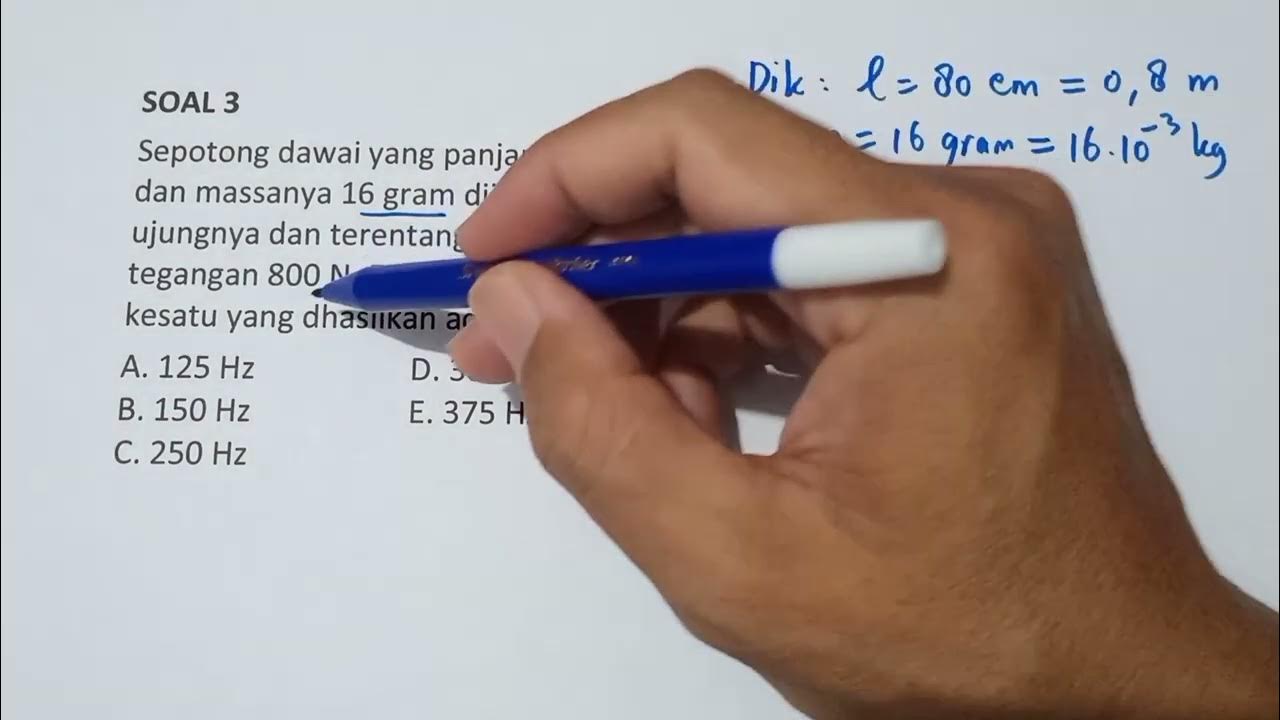Wavespeed - GCSE Science Required Practical
Summary
TLDRThis video tutorial demonstrates how to measure wave speed in both water and string using practical setups. The first part explains using a ripple tank to observe and measure the speed of water waves by adjusting the oscillator frequency and applying the wave equation. The second part covers measuring wave speed on a string, where standing waves are created by a vibration generator and mass, and the wavelength is calculated based on the frequency. The video also explores how to graph data for a linear relationship between frequency and wavelength to determine wave speed.
Takeaways
- 😀 The script demonstrates how to measure wave speed in both liquids and solids for a GCSE physics practical.
- 😀 A ripple tank is used to observe and measure water waves, with the addition of a strobe light to make wave motion visible.
- 😀 The wave equation, V = F × λ, is crucial to calculating wave speed, where V is speed, F is frequency, and λ is wavelength.
- 😀 To get accurate wavelength measurements in the ripple tank, the magnification factor of the reflected image is calculated using a credit card.
- 😀 To find the real wavelength, the measured wavelength on the screen is divided by the magnification factor (approximately 2.1).
- 😀 The script emphasizes the importance of taking multiple readings (at least five different frequencies) for reliable results.
- 😀 A graph is suggested to represent the relationship between frequency and wavelength, with the reciprocal of the wavelength plotted to get a straight line graph.
- 😀 The gradient of the graph will provide the wave speed in meters per second, which is the desired result.
- 😀 For the string wave experiment, a vibration generator is used to create waves on a string, and the wave speed is determined using standing waves.
- 😀 The wavelength of the standing waves is calculated by measuring the string's length and counting the number of loops formed at different frequencies.
- 😀 Similar to the ripple tank experiment, the frequency and wavelength are multiplied to find the wave speed, or a graph can be drawn for further analysis.
Q & A
What is the purpose of using a ripple tank in the experiment?
-The ripple tank is used to visually observe and measure the speed of water waves. It allows for easy manipulation of the wave frequency and helps to observe the relationship between frequency, wavelength, and wave speed.
How does the strobe light help in the ripple tank experiment?
-The strobe light flashes in sync with the oscillator, making the waves appear stationary. This allows for easier measurement of the wavelengths because the waves are frozen in time.
Why is it important to adjust for magnification when measuring the wavelength on the screen?
-Since the image of the waves on the screen is magnified, it’s crucial to divide the measured wavelength by the magnification factor to get the real wavelength of the waves.
How do you calculate the wave speed in the ripple tank experiment?
-The wave speed is calculated using the wave equation, V = F × λ, where V is the wave speed, F is the frequency, and λ is the wavelength. The frequency is provided, and the wavelength is measured to determine the wave speed.
What type of relationship exists between frequency and wavelength in this experiment?
-The relationship between frequency and wavelength is inversely proportional. As the frequency decreases, the wavelength increases, and vice versa.
What is the benefit of plotting a graph of frequency vs. reciprocal wavelength?
-Plotting a graph of frequency against the reciprocal of the wavelength (1/λ) results in a straight-line relationship. The gradient of this line can be used to calculate the wave speed.
Why is it important to measure multiple wavelengths for accuracy in this experiment?
-Measuring multiple wavelengths reduces the chance of errors and helps to obtain more reliable and consistent results, especially when calculating averages.
What equipment is used to measure the speed of waves on a string?
-The equipment includes a signal generator, a vibration generator (which acts like a speaker), a piece of string, and a mass to apply tension to the string.
What is a standing wave, and how is it related to measuring wave speed on the string?
-A standing wave is a wave pattern that results from the interference of two waves traveling in opposite directions. At certain frequencies, standing waves form on the string, and the number of loops helps in determining the wavelength for calculating wave speed.
How do you determine the wavelength of a standing wave on the string?
-The wavelength of a standing wave can be measured by identifying the distance between two nodes (points of no movement) or by measuring the entire length of the string for multiple loops. The wavelength is then determined based on the number of loops present.
Outlines

このセクションは有料ユーザー限定です。 アクセスするには、アップグレードをお願いします。
今すぐアップグレードMindmap

このセクションは有料ユーザー限定です。 アクセスするには、アップグレードをお願いします。
今すぐアップグレードKeywords

このセクションは有料ユーザー限定です。 アクセスするには、アップグレードをお願いします。
今すぐアップグレードHighlights

このセクションは有料ユーザー限定です。 アクセスするには、アップグレードをお願いします。
今すぐアップグレードTranscripts

このセクションは有料ユーザー限定です。 アクセスするには、アップグレードをお願いします。
今すぐアップグレード関連動画をさらに表示

Wavelength-Frequency-Speed Relationship

Pengenalan Alat Rambu Ukur, Secchi Disk, dan Bola Duga

Percobaan Melde - Menentukan Cepar Rambat Gelombang Pada Tali

GCSE Physics Revision "Required Practical 8: Ripple Tank"

Mudah Mengerjakan Soal Gelombang Dawai || Fisika Kelas XI || #oprekmafiki #fisikasma #fisikaasyik

Transverse Wave on a String | Engineering Physics | S Chand Academy
5.0 / 5 (0 votes)
